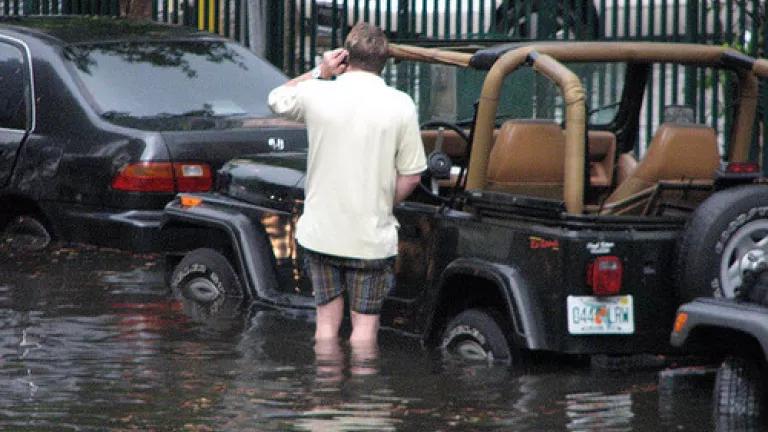
South Florida’s King Tide—an annual super-high tide brought on by a particular alignment of earth, sun and moon—is expected to peak on Thursday, raising sea level by about four feet and pushing a foot of water into the streets of Miami. In the past, king tides sent water rising up through storm drains and into the streets, leaving pedestrians in trendy South Beach sloshing through ankle-deep water. This year, construction crews in Miami Beach, where even regular high tides routinely cause flooding, are working around the clock to install pumps that will help control the floodwaters and protect the city’s $23 billion in real estate.
The flood-prone streets of Miami (“South Beach Flood,” by Maxstrz, Creative Commons 2.0)
Many are watching this year’s king tide closely–EPA Administrator Gina McCarthy will be there in person--to see how well the pumps work. But across Florida this week, many are also calling for a longer-term solution to the rising seas that threaten the state. Climate change is expected to raise sea levels in Florida two feet by 2060. This week’s King Tide, and the resulting floods, will be a preview of what Florida can expect as the climate continues to warm. In a series of events around the state, including a Florida climate summit led by scientists and business leaders, a meeting of evangelical pastors, and a town hall meeting for Hispanic families, disparate groups are gathering to call on Florida’s elected officials to take real action on climate change and protect their communities.
Florida’s geography puts the state squarely in the bull’s eye of climate change impacts. Florida has already been declared a disaster area 19 times since 2000, due to damage from hurricanes, storm surge, heavy rains, and flooding. Yet despite these hardships, present and future, Florida’s political landscape was, until recently, awash in climate change denial.
Florida residents are working to turn the tides, so to speak. And elected officials are starting to listen. When I visited Florida in August to speak at Orlando’s Climate & Energy Summit, organized by Orlando’s Mayor Buddy Dyer, it was clear that denial was no longer an acceptable response to the realities of climate change.
A recent poll shows that 8 out of 10 Floridians want to set limits on carbon pollution from power plants, the number source of climate pollution in the United States. Cities like Orlando have set emissions reductions targets and are already working to meet those goals, using strategies like improving building energy efficiency. Even Governor Rick Scott, while still keeping a foot in the climate-denial camp, recently agreed to meet with a group of scientists (whom NRDC helped bring together) to talk about climate change. Scott said he’s interested in solutions—so NRDC helped sponsor a public Climate Solutions Summit in St. Petersburg this week, where scientists, business leaders, political leaders and others brainstormed a climate agenda for the governor.
That agenda is clear. While Florida communities are uniquely vulnerable to climate change impacts, Florida also has a wealth of resources at its disposal to combat climate change. Florida’s solar energy potential is among the best in the country, with enough available energy to fulfill 70 percent of its total electricity needs. Yet Floridians send more than a billion dollars every year out of state to buy dirty fossil fuels. Florida is also in the minority of states that do not have a renewable energy standard, which requires that utilities generate a certain percentage of their energy from renewable sources, and works to encourage the development of solar and other clean, renewable energy potential. Florida is already home to more than 300 solar energy companies, which employ more than 4,000 local people. The clean energy industry as a whole employs 130,000 people across the state, according to a new clean energy job census. That’s just a fraction of the clean energy jobs Florida could create with smart energy policies that benefit both the economy and the environment.
Energy efficiency, any state’s cheapest and cleanest energy resource, hasn’t even begun to be tapped in Florida. Energy savings by Florida utilities are well below the national average. A policy called decoupling, already in use in 16 states, can make energy efficiency an incentive for utilities, instead of the current market structure which encourages utilities to make more money by selling more electricity. Policies that encourage investment in efficiency can reduce pollution and lower utility bills for consumers, instead of pushing utilities to buy dirty coal from out of state.
The potential for a cleaner, safer, more prosperous future for Florida is within reach. People want solutions to protect their homes, their businesses, their communities, and to do right by future generations. That’s why so many communities in Florida and across the nation are calling for a plan to combat climate change, and voicing support for the EPA’s Clean Power Plan to limit carbon pollution from dirty power plants, the nation’s single largest source of climate pollution.
In Florida, the Clean Power Plan is expected to save households $27 million a year and businesses $22 million on their electricity bills, as well as create 10,000 new jobs, largely through investments in energy efficiency.
Across the nation, the Clean Power Plan will save households and businesses $37 billion on their electric bills in 2020 alone, while creating 270,000 jobs in clean energy and efficiency. And that doesn’t include the tens of billions of dollars in health benefits from having cleaner air.
Through efforts like these, we can limit the carbon pollution that is driving climate change, protect our communities, and create a clean energy future. In the meantime, let’s hope those pumps in Miami do their job during the King Tide, and Florida’s leaders do their job and listen to the rising tide of public opinion on climate action.
